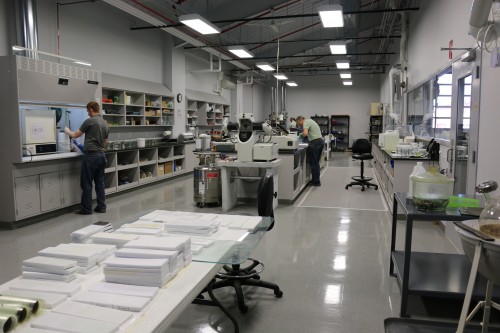
by Julie Jezowski
Above: the state-of-the-art lab where Gougeon chemists perform much of the company’s epoxy testing.
By now most of you know that we are the manufacturers of WEST SYSTEM® Epoxy. But you may not know what is involved in the manufacturing and more specifically, the formulating of WEST SYSTEM. It’s not just slapping some chemicals together and then packaging it up into a pretty box. To date, we have performed thousands of tests and generated thousands of test results. I spend large chunks of my days entering all of this epoxy testing data into our database and I am eternally amazed at all of the time, effort, and testing that goes into making our products. Because of that, I am going to take you on a short but sweet journey into the world of Gougeon Brothers epoxy testing and I believe you too will be amazed. Please keep in mind that all of these tests, which are only a few of the many, are performed right here within our very own walls.
ABS Plastic to Ziricote The range of substrates that undergo adhesion testing.
This test determines how well our products adhere to all different types of substrates. Using a pneumatic tensile test instrument (PATTI meter) a load is increasingly applied to the surface of a substrate until a stud, fastened with epoxy, is pulled off. The force of this action yields the tensile strength in pounds per square inch. To date, we have logged in 2,000+ adhesion tests.
60,000,000± The number of cycles our MTS test machine has generated performing annular shear testing.
This test helps us determine the epoxy formulation’s fatigue resistance, allowing us to see which materials can best withstand the rigors of repeated stress caused by repetitive load cycles. The specimens tested consist of a 2.0″ diameter epoxy annulus (cast in a cylindrical aluminum mold) around a central threaded ¾” × 3″ steel rod. During each test, the load is repeated many thousands of times. After some number of cycles, the epoxy material either deforms or cracks until it can no longer sustain the steel post in its original position. The test is over when the post has been displaced downward one-tenth of an inch. This lets us rank epoxy formulations on the basis of how many cycles they can withstand at a standard peak load level, or on the basis of the magnitude of the peak load required to produce failure after a standard number of cycles.
Entire length of a professional football field The combined length of all the test cylinders we have tested in Compression.
Performed with the MTS test machine, this test determines the behavior of the epoxy under crushing loads. The specimins we crush in this test are approximately 1½” long cylinders of solid epoxy. The machine compresses them at various loads. We record the peak load required to cause epoxy failure.
40,000± The days of destruction our QUV Accelerated Weathering Test Machine has logged in, satisfactorily destroying over 300 test samples.
The QUV test machine produces cycles of UV light, condensation and temperature changes that mimic the environment but at an accelerated rate, it lets us foresee the level of environmental degradation that would take place over time. If you’d like to read more in depth about the QUV process see Epoxyworks 28 for a super article.
Much, much more! Other tests performed in-house: Chemical Resistance, Creep Rupture, Cure Profile, Hydromat Panel, Lap Shear, Moisture Exclusion, Moisture Uptake, Sandability, Specific Gravity, Tensile Strength, Viscosity and Wet Out.
I hope you enjoyed this behind-the-scenes tour of our test facility here at Gougeon Brothers, where we torture and break stuff to develop and maintain the excellence of our WEST SYSTEM product line.





